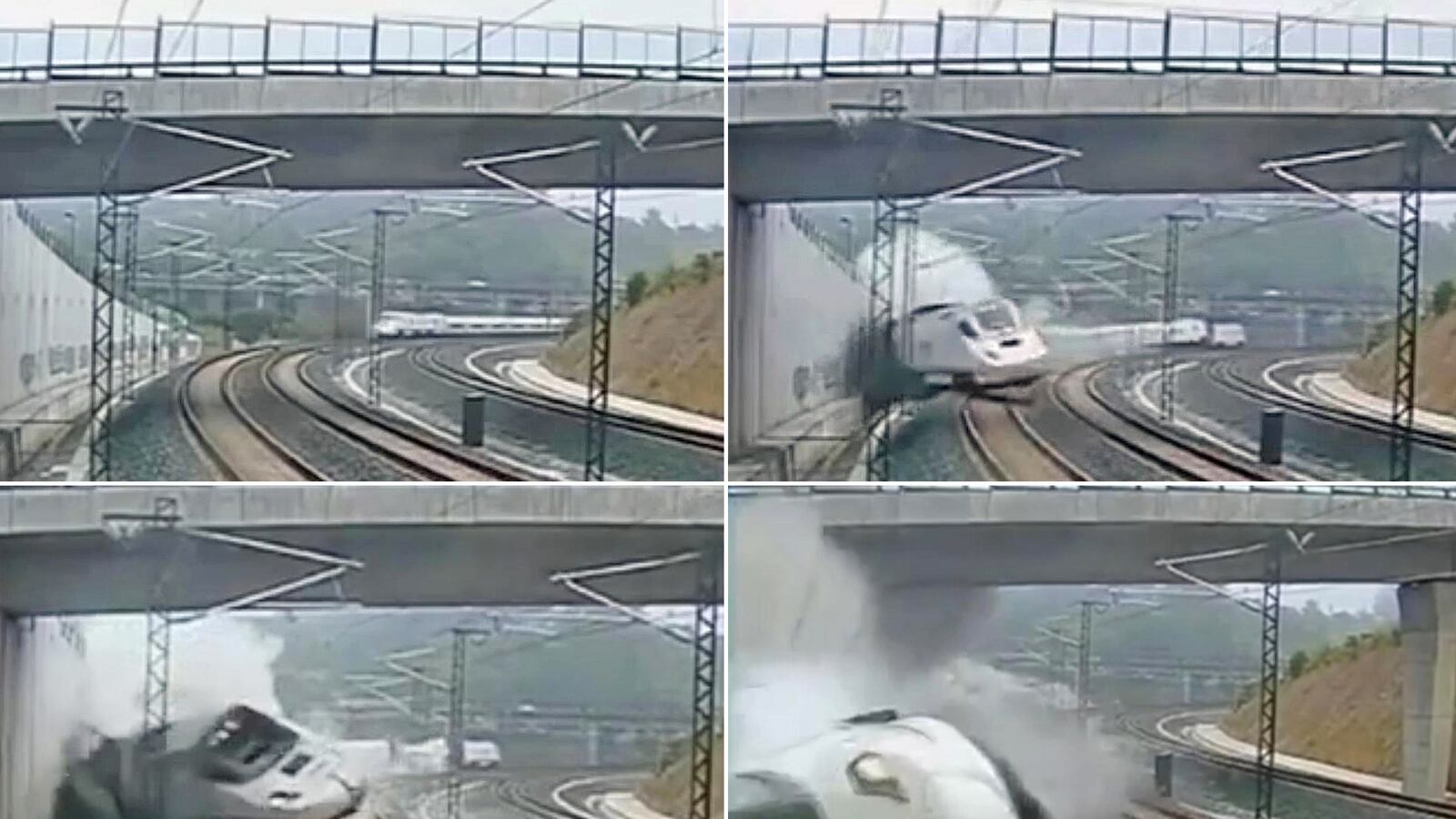The Spanish passenger train that smashed into a retaining wall on a curve just shy of the Santiago de Compostela station, killing 80 and injuring 150 passengers, was going twice the speed limit when the train’s momentum lifted the back of the locomotive off the tracks before the train buckled and derailed. CCTV footage from a camera affixed to a bridge above the curve shows precisely what a high-speed train crash looks like in real time, and television footage from the scene moments later reveals just how devastating the aftermath of such a brutal disaster is when the dust settles. “I was in the second car of the train, and we tried to squeeze out of broken windows,” passenger Riccardo Montesco told local Cadena Ser radio. “People were smashed under the train. I saw bodies. The train was on fire.”

Montesco, who was standing with dozens of passengers near the train door, was ready to get off at the Santiago de Compostela station, just a few miles down the line. The accident happened on the eve of the Day of Saint James, one of the most festive celebrations of the Catholic calendar in Spain. Pope Francis took a moment from his busy schedule in Brazil to send a telegram to the injured and the families of those who lost their lives, even imparting a special apostolic blessing on those who were en route to the Catholic celebration. “On this day when the Church entrusts herself to the intercession of James the Apostle, heavenly patron of Spain and Witness of the Risen Christ, together with my expressions of encouragement for all the children of this noble land, I cordially impart a special Apostolic blessing that comes from faith and is a bearer of consolation that offers true love.”
The 13-car train, which was carrying 247 passengers, originated in Madrid some five and a half hours before the accident. Its final destination was Ferrol, a popular launching spot for religious pilgrims walking to Santiago de Compostelo. Most of the passengers were foreigners, including five Americans who apparently survived. Only the train drivers escaped the wreckage completely uninjured—because they were belted in. Trains are not generally fitted with seat belts, so passengers were battered around inside the cars when the train struck the wall. Thirty-two adults and four children are in critical condition, some with severed limbs and life-altering injuries ranging from paralysis to severe back injuries, according to the Renfe rail authority in Spain.
The accident is the deadliest train wreck in Europe since 1998. (Al Qaeda–inspired terrorists were blamed for planting bombs that killed 191 on Madrid’s commuter trains in March 2004.) But the wreck, on the heels of deadly train accidents in Paris and Quebec earlier this month, makes for a surprising statistic: more people have been killed in train accidents than in airplane crashes globally in 2013 despite two air disasters in the last month alone. “The survivability of airplane crashes keeps getting better,” says a spokesperson for the European transportation authority. “That’s not always the same for train travel.”
The train’s primary driver, named as Francisco Jose Garzon in the Spanish press, was reportedly heard on the radio system saying “I’m only human, I’m only human” when he was extracted from the wreckage, according to Spanish media reports. But human error on railway systems across Europe should never contribute to accidents. All European rails are supposed to be fitted with a fail-stop device called a European Rail Traffic Management System, which measures the train’s speed and can even slow down a train that is moving too fast. This train was reportedly traveling at about 190 kilometers an hour on a curve where the limit was 80 kilometers an hour. It was not an AVE (Alta Velocidad Española) train, one of Spain’s newest high-speed locomotives, but it was new enough to be able to use the high-speed lines.
The driver is currently in police custody, under investigation for his potential culpability in the accident, according to a Renfe Spanish rail authority spokesperson at a televised press briefing Thursday. Many Spanish media outlets were able to grab status updates from his Facebook page, on which he frequently bragged about how fast he had driven various trains over the years. The page has since been removed, but not before many Spanish news outlets were able to post screenshots of his braggadocio. According to the newspaper El País, he also told rescue workers the accident was his fault. "I was doing 190,” the paper reported him saying. “I hope no one's been killed, because they'll be on my conscience."
Editor’s note: this article has been updated to correct the total number of passengers injured and the total number of people on the train.






